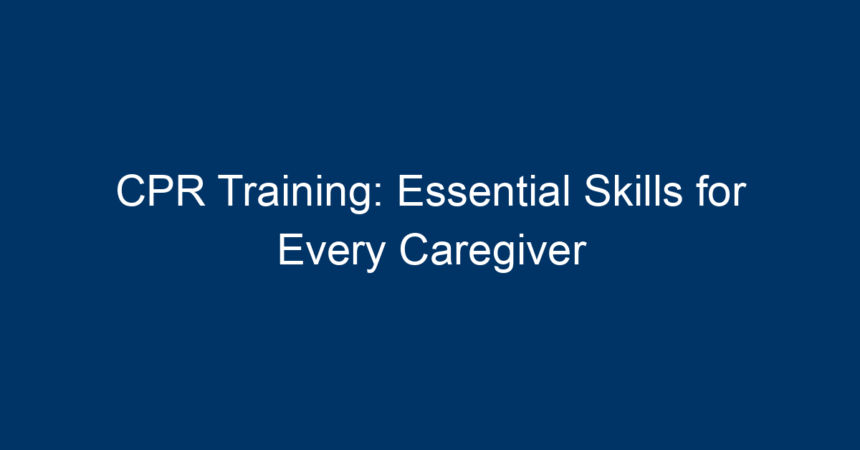In emergencies, every second counts. Whether you are a parent, a teacher, or a healthcare professional, knowing how to perform CPR (Cardiopulmonary Resuscitation) can mean the difference between life and death. CPR training equips caregivers with vital skills that can save lives, making it an indispensable part of any caregiver’s toolkit. In this article, we will delve into the importance of CPR training, the skills it encompasses, and how you can get started.
The Importance of CPR Training
Every year, countless lives are lost due to cardiac arrest. According to the American Heart Association, nearly 350,000 out-of-hospital cardiac arrests occur in the U.S. alone. In many of these cases, immediate intervention can significantly improve survival rates. Here’s why CPR training is essential for caregivers:
1. Empowering Caregivers
CPR training transforms ordinary individuals into life savers. With the knowledge and skills imparted during training, caregivers can respond quickly and confidently in emergencies, reducing the fear and anxiety associated with sudden medical crises.
2. Enhancing Workplace Safety
In many professions, particularly in healthcare, education, and childcare, having trained individuals can foster a safer environment. Many employers now prioritize CPR certification for their staff, recognizing the importance of being prepared for emergencies.
3. Community Responsibility
Being trained in CPR is not only a personal asset; it’s also a community contribution. When more individuals in the community possess CPR skills, the chances of successful resuscitation efforts increase, ultimately saving lives and meeting public health goals.
Core Skills Learned in CPR Training
Understanding the importance of CPR training is just the beginning. Let’s explore the core skills you will learn during a CPR training course:
1. Recognizing Emergency Situations
The first step in any emergency situation is recognizing when CPR is necessary. CPR training teaches you how to assess a person’s responsiveness and breathing. Key signs include:
- Unresponsiveness
- No breathing or irregular breathing
- Gasping or choking sounds
2. The Basics of CPR
Once you’ve recognized an emergency, it’s crucial to know how to perform CPR effectively. Here’s a brief overview of what you’ll learn:
a) Compressions
- Technique: Interlock your hands and place them at the center of the chest. Compress down hard and fast (at least 100 to 120 compressions per minute).
- Depth: Ensure compressions are at least 2 inches deep.
b) Rescue Breaths
- If trained, after every 30 chest compressions, give two rescue breaths. This involves tilting the chin up, sealing your mouth over the victim’s mouth, and blowing air into their lungs.
3. Using an AED
Automated External Defibrillators (AEDs) are life-saving devices that can restore a normal heart rhythm during a cardiac arrest. During CPR training, you’ll learn how to:
- Locate and activate the AED.
- Attach the pads correctly.
- Follow the device’s audio and visual prompts.
4. Special Situations
CPR training also covers special situations such as:
- CPR for infants and children: Techniques and compression ratios differ for younger patients.
- Choking: Techniques such as the Heimlich maneuver are crucial to understand for choking emergencies.
Finding CPR Training Programs
Investing in CPR training can be one of the most valuable decisions you make as a caregiver. Here’s how to find the right program:
1. Accredited Organizations
Look for accredited organizations like the American Heart Association or the Red Cross that provide certified CPR training courses. These organizations ensure the training aligns with the latest guidelines and best practices.
2. Online vs. In-Person Training
While online courses can be convenient, in-person training offers hands-on experience. Consider your learning style and availability when making the choice, but prioritize courses that include practical elements.
3. Certification Validity
Most CPR certifications are valid for two years. Make sure to stay updated with refresher courses and renew your certification regularly to maintain your skills and knowledge.
Overcoming Barriers to CPR Training
Despite the clear benefits, some caregivers may hesitate to pursue CPR training. Here are common barriers and ways to overcome them:
1. Time Constraints
With busy schedules, finding time for CPR training can feel daunting. Many organizations offer flexible schedules, including weekend or evening courses. You can also consider online courses that you can complete at your own pace.
2. Fear of the Unknown
Some individuals may feel intimidated by the idea of performing CPR. Remember, training is designed to provide you with the confidence and competence needed to act when it matters most. Practice and repetition during training will help alleviate fear.
3. Cost Considerations
While some programs may have associated costs, investing in CPR training can be seen as an investment in safety. Look for scholarships or free community programs that make training more accessible.
Conclusion: Take Action Today
CPR training is more than just a skill; it’s a vital life-saving tool that every caregiver should possess. By being prepared, you not only enhance your ability to respond in emergencies but also contribute to the safety and well-being of your community.
Take the first step today—research local CPR training programs, and consider enrolling in a class. Whether you’re a parent, educator, or healthcare professional, knowing CPR can empower you to make a difference in someone’s life when it counts the most. Remember, every moment matters in a medical emergency, and being prepared can save lives.
Incorporate CPR training into your skill set, and stand ready to respond when duty calls. Your preparedness could be the lifeline someone desperately needs.




